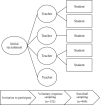The impact of epistemic framing of teaching videos and summative assessments on students' learning of scientific methods
- PMID: 35399299
- PMCID: PMC8988941
- DOI: 10.1080/09500693.2021.1998717
The impact of epistemic framing of teaching videos and summative assessments on students' learning of scientific methods
Abstract
The incorporation of epistemic aspects of science in science education continues to be a challenge for researchers and practitioners. The paper presents an empirical study investigating how epistemic framing of scientific methods can be incorporated in science teaching, learning and summative assessment, and what impact such framing has on student learning outcomes. The study was conducted with 969 secondary students taught by 152 teachers from a national sample in England. Teaching videos and summative assessments were framed by Brandon's Matrix, a theoretical framework derived from the work of a philosopher of science and focusing on the diversity of scientific methods ranging from hypothesis testing to non-manipulative parameter measurement. The findings are discussed, including (a) the students' views on the teaching videos and summative assessments, (b) the impact of the teaching videos on students' understanding of the epistemic aspects of scientific methods and (c) students' performance on summative assessments in the context of science topics covered in high-stakes examinations in England. The findings suggest that the students' understanding of scientific methods significantly improved after watching the videos. Furthermore, the students' performance on the summative assessment items indicated a high level of accuracy in responses.
Keywords: Epistemic framing; scientific methods; summative assessment; teaching videos.
© 2021 The Author(s). Published by Informa UK Limited, trading as Taylor & Francis Group.
Conflict of interest statement
No potential conflict of interest was reported by the author(s).
Figures
References
-
- Abd-El-Khalick, F., & Lederman, N. G. (2000). Improving science teachers’ conceptions of the nature of science: A critical review of the literature. International Journal of Science Education, 22(7), 665–701. 10.1080/09500690050044044 - DOI
-
- Akgun, S., & Kaya, E. (2020). How do university students perceive the nature of science? Science & Education, 29, 299–330.
-
- Allchin, D. (2006). Lawson's shoehorn reprise. Science & Education, 15(1), 113–120. 10.1007/s11191-005-8922-9 - DOI
-
- Au, W. (2007). High-stakes testing and curricular control: A qualitative metasynthesis. Educational Researcher, 36(5), 258–267. 10.3102/0013189X07306523 - DOI
-
- Barzilai, S., & Zohar, A. (2012). Epistemic thinking in action: Evaluating and integrating online sources. Cognition and Instruction, 30(1), 39–85. 10.1080/07370008.2011.636495 - DOI
LinkOut - more resources
Full Text Sources




